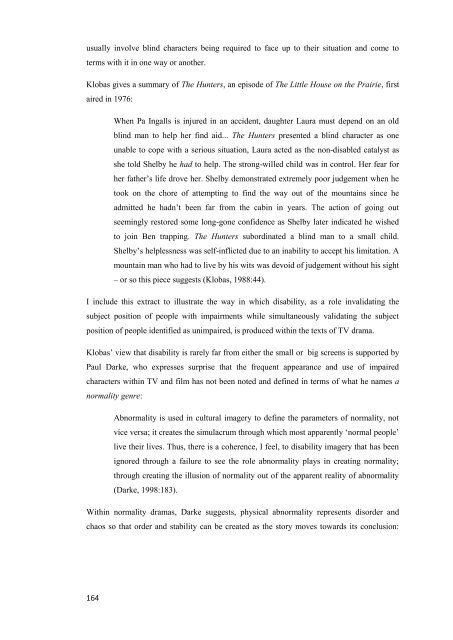A thesis submitted in partial fulfilment of - Etheses - Queen Margaret ...
A thesis submitted in partial fulfilment of - Etheses - Queen Margaret ...
A thesis submitted in partial fulfilment of - Etheses - Queen Margaret ...
Create successful ePaper yourself
Turn your PDF publications into a flip-book with our unique Google optimized e-Paper software.
usually <strong>in</strong>volve bl<strong>in</strong>d characters be<strong>in</strong>g required to face up to their situation and come to<br />
terms with it <strong>in</strong> one way or another.<br />
Klobas gives a summary <strong>of</strong> The Hunters, an episode <strong>of</strong> The Little House on the Prairie, first<br />
aired <strong>in</strong> 1976:<br />
164<br />
When Pa Ingalls is <strong>in</strong>jured <strong>in</strong> an accident, daughter Laura must depend on an old<br />
bl<strong>in</strong>d man to help her f<strong>in</strong>d aid... The Hunters presented a bl<strong>in</strong>d character as one<br />
unable to cope with a serious situation, Laura acted as the non-disabled catalyst as<br />
she told Shelby he had to help. The strong-willed child was <strong>in</strong> control. Her fear for<br />
her father‟s life drove her. Shelby demonstrated extremely poor judgement when he<br />
took on the chore <strong>of</strong> attempt<strong>in</strong>g to f<strong>in</strong>d the way out <strong>of</strong> the mounta<strong>in</strong>s s<strong>in</strong>ce he<br />
admitted he hadn‟t been far from the cab<strong>in</strong> <strong>in</strong> years. The action <strong>of</strong> go<strong>in</strong>g out<br />
seem<strong>in</strong>gly restored some long-gone confidence as Shelby later <strong>in</strong>dicated he wished<br />
to jo<strong>in</strong> Ben trapp<strong>in</strong>g. The Hunters subord<strong>in</strong>ated a bl<strong>in</strong>d man to a small child.<br />
Shelby‟s helplessness was self-<strong>in</strong>flicted due to an <strong>in</strong>ability to accept his limitation. A<br />
mounta<strong>in</strong> man who had to live by his wits was devoid <strong>of</strong> judgement without his sight<br />
– or so this piece suggests (Klobas, 1988:44).<br />
I <strong>in</strong>clude this extract to illustrate the way <strong>in</strong> which disability, as a role <strong>in</strong>validat<strong>in</strong>g the<br />
subject position <strong>of</strong> people with impairments while simultaneously validat<strong>in</strong>g the subject<br />
position <strong>of</strong> people identified as unimpaired, is produced with<strong>in</strong> the texts <strong>of</strong> TV drama.<br />
Klobas‟ view that disability is rarely far from either the small or big screens is supported by<br />
Paul Darke, who expresses surprise that the frequent appearance and use <strong>of</strong> impaired<br />
characters with<strong>in</strong> TV and film has not been noted and def<strong>in</strong>ed <strong>in</strong> terms <strong>of</strong> what he names a<br />
normality genre:<br />
Abnormality is used <strong>in</strong> cultural imagery to def<strong>in</strong>e the parameters <strong>of</strong> normality, not<br />
vice versa; it creates the simulacrum through which most apparently „normal people‟<br />
live their lives. Thus, there is a coherence, I feel, to disability imagery that has been<br />
ignored through a failure to see the role abnormality plays <strong>in</strong> creat<strong>in</strong>g normality;<br />
through creat<strong>in</strong>g the illusion <strong>of</strong> normality out <strong>of</strong> the apparent reality <strong>of</strong> abnormality<br />
(Darke, 1998:183).<br />
With<strong>in</strong> normality dramas, Darke suggests, physical abnormality represents disorder and<br />
chaos so that order and stability can be created as the story moves towards its conclusion:




